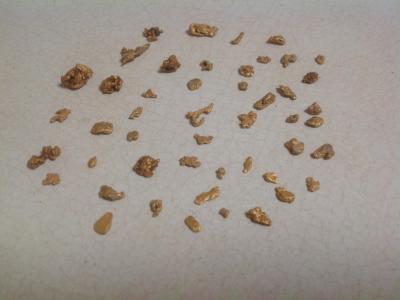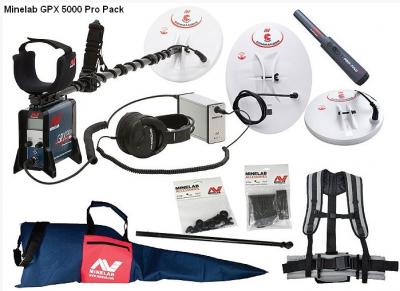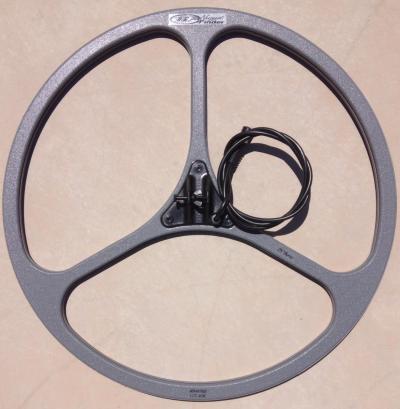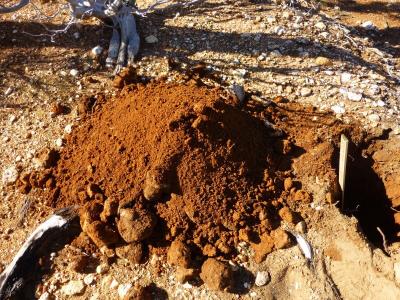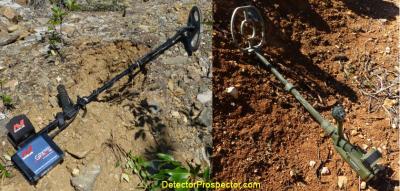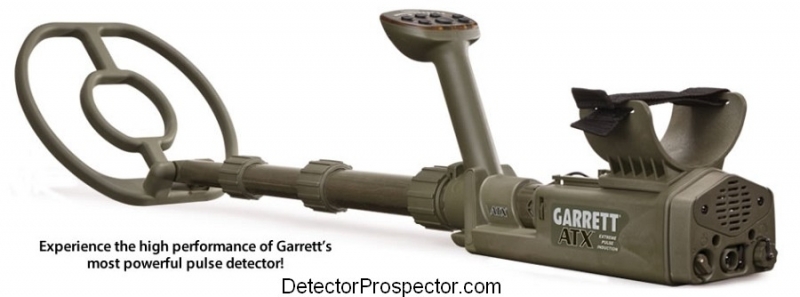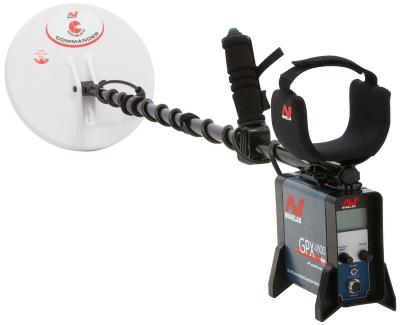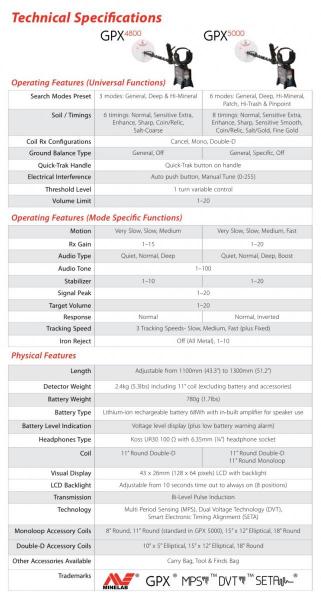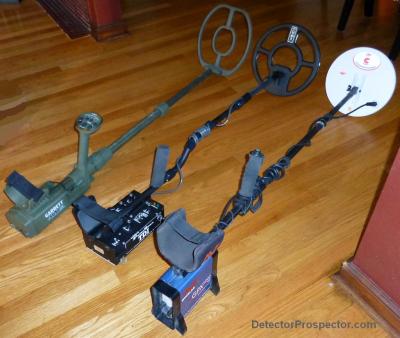Search the Community
Showing results for tags 'minelab gpx'.
-
I am looking for advice from the GPX Veterans on the forum. I recently acquired a GPX 4800. The stock coil with the 4800 is the 11" DD. I am thinking that my approach to learning this machine should be to read as much as possible about the settings, and log hours detecting. Not really a novel approach. So should I buy a mono coil now, or wait til I get more experience with DD? I have a feeling that at this point along the learning curve I may not even be able to tell the difference. Luckily I didn't get two coils so I don't have the problem of deciding which to use.
-
I want to make a external battery set up for my GPX 5000. I already have the correct 7200 MAH LiPo battery. I purchased an external headphone amp from Jonathon Porter. (JP) What I'm having trouble finding is the 5 pin male CB Microphone plug. And after I find one, how do I wire it from the LiPo Battery . I have Deans plugs and wire to go the 5 pin. But the battery has a + and a - , the 5 pin has (of course) 5 pins. So which pins do I wire to. I don't want to fry my GPX 5000. Any input appreciated.
-
been camping in az for over three weeks and have pulled out 46 nuggets for about 3/4 ounce cleaning up old areas but my 4500 went down over a week ago and had to send it in, the repair center is less than an hour from me but I can't even get a return call from them to know what is wrong, the man that used to run their center in Vegas was good, so far I am not impressed with the new centers customer service, hopefully they will restore my faith with a reasonable repair this week, I have been using a 2200d with a Joey for the last several trips and although I still pulled out 10 nuggets, it is a real challenge changing machines when you have hunted with the same one for at least five years. As soon as I get my machine back I will be ready to start prospecting new areas, Rich Lampright is heading this way, hope to see you Steve, there is a lot of water damage in the Bradshaws. Been looking at a Whites TDI for a backup, not sure if they are a good machine, any input is appreciated
-
Yesterday I took Calgeologist out to my claim for a few pointers on his new to him GPX5000. I think he had already memorized the owners manual and read everything he could from a few forums. That made it easy as there was not much more for me to do. I had him hook up an external speaker and walked with him for advice on various targets and sounds. He chose to use the Commander 12x15 Mono, a bit of an overkill but he did not have any smaller mono coils in his arsenal. After awhile I let him go on his own and started my own hunt. An hour later he came up to me and asked for some help, by then I had switched to my new GB Pro after beating the skunk away with the GPX. He told me he had gotten a target out of his dig hole and asked me if I could help end his frustration and point it out for him. He pointed to the spot he figured it was and bingo the GB said he was correct. I got a mild signal and had the target in my scoop. It gave a nice signal on the front sensitive portion of his monster coil and when I spotted his target after a few cuts I was totally blown away... I mean it was unbelievable. He found a small birdshot a few inches deep. He was hunting in sharp timing, slow motion and I think quiet with the gain set higher than factory setting. Can't remember his gain setting for sure. Just amazing the sensitivity of that coil...... and he did not even have it in Fine Gold timing! If some one told me they could find birdshot with that coil I would be pulling on my extra high Bshort boots! I also think nuggets are in serious trouble when he gets a bit more experience under his belt.
-
Hey all, Just got my hands on a 5000 and took it out for a spin today. I have one question. Are targets going to always have the high low sound? Or will some have a single sound (high or low)? I was getting quite a few subtle single tone sounds. I figured they were just hot areas, but they had the same kind of sound a good target on my GMT would have. The obvious answer would be to dig all of them, but I was also learning how to pinpoint with a larger coil and some of these sounds got lost when digging. Thank you!
-
When I was big in coin hunting most of the time I used a small coil. One reason was you had less trash under the coil and the ID work better. Another reason that small coil would detect the very small coin are gold ring. I knew I loss depth but I'd come back with the large coil to punch down deeper. We all know a small coil will detect the very small and it will detect something larger if in the ranger of the coil. The small and large coil has a limit in relation to the power of the detector. I can take the GPX 5000 and put a small coil to detect the small gold. Now I got the small coil with the power of the GPX. Then I can pull it off and go with the big one for the depth but loose the very small gold. Remember small coil small gold and large coil will detect some small gold with more depth over all. The SDC 2300 has shown it's hot for the very small gold and it's going to detect other gold in the range of that 8 inch coil. This detector has to have the power but is limited by the size of the coil on depth. Again it's small coil small gold and in the case of the SDC very small gold. My thinking on the SDC 2300 is only limited by it's coil.Now if I could change out the coil for a larger one could it be near the GPX 5000. I think Minelab has a detector in the SDC 2300 that is so near being a GPX 5000. In having the coil on the SDC 2300 hard wired will keep the sales up on for both. detectors. Oh if I could only put another coil on the SDC 2300. Then I just may save me two thousand dollars buying the SDC. but right now Minelab will keep us in the dark on this subject. Here we are with a GPX that I can get a small coil to detect the very small gold. It's not a lot of trouble to change from one coil to another. I can get a lower shaft for the smaller coil and that's makes it less trouble Oh the SDC is new it's blue and I fell in love with this new blue toy. Ha I can't blame you if you go get a SDC 2300. What's not to love in a new blue toy and waterproof. Chuck Anders PS I'm sorry to repeat myself at times. That's the way life is after you go over a few hills. HaHa
-
So a couple weeks ago I was out detecting with my GPX 5000 and all was going well. Steve Herschbach and I were hunting a spot where there are several patches in a comparatively small area a few hundred yards up to a quarter mile apart. At the last place of the day, I took out my GPX and turned it on, and it sounded weird (the 5000 goes through a specific set of tones on boot up and I know what is normal). I looked at the display screen and it was off - it looked the same as when the detector is off. It was making some faint sounds and I waived some metal objects past the coil and it did make a weak sound as the metal went by - but it was obviously malfunctioning and with the screen off, I could not adjust the sound upward even if I wanted. I tried a second power cord and that made no difference. I tried another coil - also no change. So I sent the unit into minelab for repair. They rebooted the unit to all the factory presets and it worked fine. Apparently this happens sometimes that the computer gets itself set to some weird setting and it wont run right unless reset to the presets. Turning on and off is effectively a partial re-boot, while retoring factory pre-sets is a full and total reboot. Sometimes that is what it takes. So, the moral of this story is......... if you find that your Minelab GPX 4000 to 5000 model seems broken, try a different power cord, try another coil (both these I already knew), but also try rebooting to all the factory preset settings. Here is the procedure from the GPX 5000 manual: To restore all Factory Preset settings: 1.Turn the detector off. 2. .Press the On/Off switch down and hold until the Reset Defaults menu appears (approximately. 5–6 seconds). 3. Turn Function Select to the right to select All Settings (as shown on the diagram). 4. Turn Setting left or right to restore all Factory Presets.The detector will restore Factory Presets and re-start. Just thought this falls into the category of stuff worth knowing if you own a GPX detector.
-
Not a big deal but I pass on news when I see it. Minelab is now packaging some popular options along with the GPX 5000 which might be a good deal for anyone who actually wants those extra items. The Minelab GPX 5000 at MAP (minimum advertised price) of $5795 includes: • GPX 5000 • Harness • Headphones • 11" Monoloop Coil • 11" Double D Coil • Battery and battery cable The Minelab GPX 5000 Pro Pack for MAP $5975 ($180 more) also includes: • 15" x 12" Monoloop Coil • Lower Shaft (spare) • PRO-FIND 25 Pinpointer • GPX Coil Wear Kit • GPX Armrest Wear Kit • Minelab Carry Bag The 15" x 12" mono coil is a great accessory coil that by itself has a MAP of $366 so this really is a good deal if you were planning on getting these items anyway. I have a GPX 5000 already but if I was getting a new one this would be the package I would get. Any dealer offered free stuff would be on top of this so look out for anyone trying to tell you they are tossing this stuff in to make the sale.
-
Seems like I am pretty well outfitted these days. There is just not much I need when it comes to metal detecting. But I did just decide to go ahead and spring for a 25" Nugget Finder round mono coil for my GPX 5000. One of my main coils for the last few years has been an 18" Nugget Finder mono that Jonathan Porter gave me when Chris Ralph and I were in Australia. It was a coil I borrowed early on and then used nearly the whole month I was in Australia. I liked the overall combination of ground coverage and large nugget depth, yet it surprised me with how small a nugget it could still detect. JP saw how much I liked the coil and was kind enough to let me take it back to the States with me. I actually owned an earlier four spoked white version of the 25" coil that I used at Moore Creek a few times. I ultimately decided the coil was more than I wanted to swing and it was too big to pack into a suitcase for air travel. I sold it and have not missed it much. I spend so much time in brushy terrain and steep terrain that I rarely am someplace such a coil would be practical. What you need is flat, open, deep ground with a possibility of large gold. It turns out there are some places like that I will be visiting this summer. I decided a larger coil would be a good idea but was still worried about going too big. I considered the 20" mono, but it just did not seem like a large enough difference compared to the 18" to be worth the money I would be spending. So I decided to go all the way and go for the 25" Nugget Finder Advantage. I did prove to my satisfaction at Moore Creek that this huge coil can pull up large gold others miss. We had a flattened tailing pile next to the cabin that produced so many nuggets it was called the "Honey Hole". After one week of it getting pounded by the visitors I went up and flagged several deep, weak targets and then I cheated. I went and got the backhoe and dug them up! A 25" coil should actually come with a backhoe. Three out of five targets were nice nuggets a weeks worth of people carefully hunting had missed. At over two pounds I will not use this coil a lot, but I will give it a good go in relatively flat, open ground that has been hunted already to the point of being dead of targets. One decent nugget will pay for the coil so that will be the goal this summer - to at least find a nugget that pays for the coil. But maybe, just maybe, it will find something really noteworthy. I will report back when and if that happens. The new Nugget Finder 25" Advantage is a three spoked gray coil. These silly things are going for $629 these days. A good chunk of that goes to get the coil from Australia to the US and then to the dealer. The shipping cost on these coils is horrendous; they do not weigh much (37 ounces) but they bulk out something fierce when put in a box. I have not actually purchased the coil yet so if somebody has a used one they want to part with let me know. Looks like I need to take a good picture of one of these to post later. Nearly every photo on the internet is actually a smaller coil billed as a 25" and the few that look like they are 25" coils are watermarked. Photo of my new coil added 4/20/14
-
I have used the Minelab GPX 5000 since it was introduced, and in fact probably owned the first one in Alaska. I have used the Garrett ATX also since it came out with one of the first units off the production line. I have been putting this review off while I got to know the ATX. I now have over 100 hours on the detector in a variety of environments so the time has come. This metal detector comparison review was very challenging for me to write. It pits two very different yet very similar detectors against each other. In a way it is almost like discussing three detectors instead of two, and there is the issue of a huge price difference. I apologize for the length but this is a case where I wanted to be as thorough as possible on the subject. This is the review you will never see published in a magazine! In a way it is all about that price differential. If the two detectors were priced similarly there would be much less debate than is going to occur amongst people and a far easier buying decision for some to make. For me personally it really is a story of the Garrett ATX being two very different detectors at once and so I will start the review there. I have been metal detecting over forty years now, and metal detecting is very important in my life. Not a day goes by that I do not think about, write about, or actually go out metal detecting. Luckily for me a large chunk of my income is derived from metal detecting and so I can justify a collection of metal detectors for what I do. I engage in quite a few detecting activities and I strive to have the very best detector possible at my disposal for whatever it is I am doing. Because of this I am constantly on the look for new detectors that might help me in some way. However, now that the technology is maturing I have the bases pretty well covered. The only thing I was still looking for was a detector that satisfied me while water detecting in Hawaii. Every other detecting scenario I have covered to my satisfaction, but every time I hit the water in Hawaii I was left wanting something better than was available. The combination of salt water, volcanic rock, and military grade electrical interference is very challenging for any detector. What I generally want is a combination of stability and power with good ergonomics. The perfect detector should only signal on desired targets and nothing else, at good depth, while feeling good on my arm. I obviously reject detectors that get poor depth - these are usually the lower price detectors. Most top tier models are very competitive in the depth department. Other detectors I have put aside solely due to an inability to handle electrical interference. Fine machines otherwise, but unstable in an urban environment. Other detectors are too noisy in mineralized ground or too chatty in dense trash. And finally, some detectors are holdovers from the old days of heavy and clunky. I do not like detectors that make my arm hurt! I was therefore very excited when I heard the Garrett ATX was on the way. I was very familiar with its predecessor, the Garrett Infinium, which was tantalizingly close to my perfect Hawaii detector. Unfortunately the Infinium suffered in the stability department. I was also aware of the Garrett Recon Pro AML-1000 military demining detector. I was intrigued by its having a non-motion monotone search mode and wondered if that could be incorporated into a new improved "Infinium Pro" model. I not only had Hawaii in mind but started envisioning scenarios involving underwater sniping for gold employing a metal detector. Add to this that neither Minelab nor White's seemed interested in putting a waterproof ground balancing pulse induction metal detector in my hands. I never expected it would be Garrett that would come out with a second generation model based on the Infinium before anyone else got to first base. I have told you all this to explain what I was expecting and hoping for in the Garrett ATX. The fact is Garrett delivered with flying colors on my desires and the ATX is now one if the most important detectors in my collection. I have already paid for the detector with jewelry found and it is the Hawaii detector I always hoped for. Garrett ATX in Hawaii If we are talking about the Garrett ATX as a new waterproof detector for use on black sand or volcanic island beaches the review can end right here. The Garrett ATX is a superb detector for those conditions and well worth the money. There is only one fly in the ointment. If you look at the full page ads for the Garrett ATX it is clearly being marketed as a prospecting detector, and one pretty clearly aimed at Minelab's top end models. Specifically "The ATX performs head-to-head with the most expensive prospecting detectors in the world." ads by Amazon... Interestingly enough this idea was not even on my radar. I had always thought it was a huge mistake for the Infinium to be set up as direct competition for the high end Minelabs. Anyone involved in that remembers the hype and resulting disappointment and backlash. The Infinium eventually found its place but more as a water and relic hunting machine than a prospecting detector, although it is a capable enough unit. My hope was to avoid a similar scenario with the ATX. I do not like hype and prefer things to be under sold so people are pleasantly surprised when their expectations are exceeded. Hype leads to disappointment when inflated claims cannot be met. The reality here however is that Garrett has chosen to make prospecting the battlefield of choice. There is a lot of money at stake here for a lot of people, and so I am going to do my best here to compare the two units as dry land prospecting detectors. I think we can all agree that if you are looking at both the Garrett ATX and Minelab GPX 5000 and need the detector to be waterproof the Garrett ATX wins hands down. The funny thing here is that if Garrett was gunning for Minelab then in my opinion they went about it the wrong way. I get the distinct impression the design process was backwards. It was not a matter of "what do prospectors want in a metal detector?" I think it was "we have this housing on the shelf we developed at great expense to go after a military contract. We need to leverage our development cost by putting something in that housing we can sell to the public." In other words, I do not see any sign of design following function. All I see is a prospecting detector crammed in a box inappropriate for the desired end use. If Steve Jobs was into metal detectors he would be rolling in his grave. I will have to suffice instead by simply shaking my head at missed opportunity. I will explain more about that later. Let's set ergonomics aside though for now and just talk about straight up prospecting performance. How does the Garrett ATX fare against the Minelab GPX 5000 on gold in mineralized ground? I have done fairly extensive tests but I do have to throw in the caveat that the world is a big place and when you discuss prospecting detectors one truth is paramount. It is all about the ground mineralization and hot rocks. What works well in one place fails in another, and for this reason alone I cannot offer 100% assurances. I have spent a month traveling Western Australia detecting every day and so I am quite familiar with what prospectors face there. I am not about to begin to offer more than an opinion about how these two detectors fare in the worst Australian ground but I do think my conclusions will prove to be true. I can tell anyone right now knowing detectors the way I do that either machine will prove superior at certain locations given their differing capabilities. In a nutshell, the Garrett ATX has a ridiculously good circuit. The engineers at Garrett have done a superb job of producing a detector that out of box performs extremely well on a wide variety of gold in a wide variety of ground conditions. I tested both units in some very red mineralized soil, both outfitted with stock DD coils. The ATX comes with a 12" x 10" DD coil. The GPX 5000 comes with two coils, one of which is an 11" round DD coil and this is what I used. The nuggets ranged from 0.1 gram to 6.5 ounces. Test conditions The impression I was left with was definitely not how the GPX 5000 blows the ATX away but instead by how well the Garrett ATX does. It is impossible to not be impressed by how well the $2120 detector does when run head-to-head against a $5795 detector. Garrett has done a fantastic job and in my opinion their advertising claims are not off base. This is a serious prospecting circuit well worth consideration. The two detectors basically differ in the range of gold they find best. The Garrett ATX skews towards the smaller more commonly found gold nuggets. The Minelab GPX 5000 skews towards larger gold nuggets that tend to be the goal of professional prospectors. Out of box with similar coils the ATX will find small gold nuggets the GPX 5000 would normally miss without special coils and tuning tricks. It does this simply and with no fuss. However, in mineralized ground with similar coils the GPX easily bests the ATX on large nuggets. By large I mean one ounce and larger and by easily I mean by a margin of 10-15%. The GPX 5000 does this using a coil that in my case had never been on the detector before. Most Minelab users would never consider hobbling the detector by putting the 11" round DD coil on if hunting large nuggets at depth. It is informative therefore that even doing this in the interest of "fairness" and with nothing more than stock Normal timing with Gain bumped to 16 (out of 20) the Minelab GPX 5000 easily outperformed the Garrett ATX on a 6.5 ounce nugget. The ATX was at max Gain of 13 for the test. Now the depth differential here was only about two inches but I have to throw in the huge caution note again that it will vary depending on ground conditions. Absolute depth was about 17" ATX versus 19" GPX for good solid signals. The kind nobody can miss. Again, do not take these as some sort of magical numbers as ground conditions and even nugget shape and alloy could cause you to get some surprising differences. That is why I hate mentioning exact depths and differences in most cases and just stick to relative conclusions. But you are going to ask so there you go. For reference a Fisher Gold Bug Pro with 13" round DD coil and White's GMT with 14" elliptical DD both with settings jacked to the max were barely able to obtain this solid gold 6.5 ounce nugget at 12" in this ground and the GMT in particular would not really have been able to hunt maxed out the way it was. Depending on who is reading this the response may be "really, only two inches?" or "wow, two whole inches!" Similarly, it is interesting to see the GPX with DD coil scrub a little nugget with no signal that the ATX easily detects at a couple inches. This however does end up being my basic and not new finding by any means. Others have reported similar results. The ATX does better on small gold and the GPX on large straight out of box with stock DD coils. I do believe the GPX has more ability to handle more varied and more intense ground conditions and hot rocks due to its many adjustments. However, this is more a belief than a fact as so far the ATX has easily handled everything I have thrown at it, including salt water, basalt rocks, and electrical interference in Hawaii. Garrett does make use of a salient fact in its advertising. The ATX handles a wide range of conditions with deceptively few settings. This makes it very easy to set up and it avoids a common complaint with the GPX detectors. They are so complex people are often left wondering if they have the optimum settings for the conditions. I know for a fact from observation that many people tend to use timings that are too aggressive for the actual conditions when using a GPX. The tendency often is to find something that seems to work well and then to just default to that way if doing things, even if conditions change. To get the best performance out of a GPX does require that a person be somewhat of a tuning wizard. The bottom line for many more casual prospectors in the United States especially is that the Garrett ATX represents a fantastic value. It is truly impossible to say but in my case at least most of the gold I find in the US with my GPX an ATX would have found it also. In particular when hunting areas where bedrock is a foot or less the ground would have to be extremely hot indeed for the ATX to not only find what the GPX will but to have an edge on the more common small gold. Even in deeper ground as long as the gold is measured in grams and not ounces and the ground not extremely mineralized the ATX is going to be a close match with the GPX. Again, out of box with stock DD coils. Where the ATX is going to clearly come up short is on large nuggets, especially those sought after 1 ounce and larger nuggets at depth and on gold in the worst mineralized ground and hot rock locations. To be perfectly honest I feel my putting an 11" inch round DD coil on my GPX 5000 in the interest of being fair does not reflect for one second how I look for gold. I am not out there being fair, I am out there looking for gold. I will be running a larger mono coil with settings optimized for larger gold and then the difference in large gold performance between the ATX and GPX is even more pronounced. I would consider a 10-15% to be a bare minimum advantage gained while in effect running the GPX with its hands tied. I have not done comparisons on the iron discrimination systems but I find the method used by the ATX to be inherently more reassuring. The GPX reacts to shallow ferrous targets by blanking out, a sort of non response. The ATX has a momentary ferrous check that kicks in at the touch of a button, and that gives a low tone growl on iron, which provides a more nuanced and natural response expected by most detector users. I am not a big fan of using discrimination on either unit but I did find the ATX method more to my liking for confirming shallow ferrous stuff as trash that I already thought was trash due to the response. Note that on either detector the ferrous rejection only works on shallow items and only with a DD coil. The amount of rejection is adjustable on the GPX and preset on the ATX so more tests really need to be done in this regard to determine which is the more accurate and useful system. Minelab GPX 5000 and Garrett ATX (Minelab outfitted with optional Nugget Finder coil) I do own both detectors and there is a simple reality here. If I am going looking for gold in the water, be it jewelry or nuggets in a creek, I will grab the ATX. For any other prospecting, the vast majority of it, I will be using the GPX 5000. I am not sure where the line between casual and serious is, but I am way, way over on the serious side. I spend a great deal of time targeting and hunting deep ground looking in areas where very large nuggets have been found historically. Most of the ground I detect I am hunting because it has produced nuggets weighing a pound or more in the past. I hunt tailing piles a lot so bedrock is tens of feet down, and the gold can be at any depth from shallow to extremely deep. I think most professionals would tell you that small gold is what happens along the way while looking for the big stuff, and at the end of the day it is the big stuff or the lack of it that makes the difference. I found over thirteen ounces of nuggets metal detecting in 2013 which is no great sum of gold in my book, but well over half of it was in the form of two nuggets, one weighing 6.5 ounces and the other 2.37 ounces. Now in this case the ATX would have found both these nuggets. Yet I would not use anything but a Minelab GPX for what I am doing. I am spending a lot of valuable time going over ground that I may only get one shot at. I plan these things well in advance and not only time but good money is invested in taking my best shot at getting good results. I basically cannot afford to be running anything that I feel does not give me the best chance of delivering that make or break it big nugget. One nugget can make all the difference between a month of lackluster results and fantastic success. If both the Garrett ATX and Minelab GPX 5000 detectors had exactly identical electronic performance I would still be swinging the GPX. I am on one hand very impressed with the ATX as a nugget detector and on the other hand very disappointed by it. The up front decision to use the Recon AML-1000 housing is an automatic fail from a nugget detecting perspective in my opinion. It adds not only needless weight but weight that is very much an impediment in rough, uneven terrain. This is accentuated by a stock coil that is sensitive to knocks and bumps. It requires an extra level of coil control to manipulate the detector in such a way as to not produce excessive false signals. This differs from Minelab coils that basically do not false at all unless something is wrong with them. I would caution anyone using a detector the way I do that the ATX requires extra care as regards the possibility of repetitive motion injury. Trust me as somebody who detected too much one year and ignored the signs this is something to regard seriously. A harness is a must for weeks of long daily use of the ATX. I shudder to think about how the detector feels with the 20" long rear mounted mono coil hanging off the front. That is an ergonomic nightmare. The ATX features silicone lubricated battery door o-rings that collect dirt. The coil connectors also have o-ring seals and even worse delicate pin connectors subject to damage if not carefully lined up. The headphone connector is similar to the coil connectors. All these are required to make the detector waterproof and not only unneeded for normal dry land use but an impediment as regards serviceability in the field. The coils are sold as a unit with the telescoping rod assembly adding needless expense and weight and making carrying an extra coil around something to be avoided. The rear mount enables the ability of the detector to fold up but is another weak point from a serviceability aspect and ergonomically the worst way to mount a coil. I always considered ergonomics to be the easy low hanging fruit for anyone considering manufacture of a detector to compete with the Minelab PI series, and I am frankly amazed anyone could make something even heavier I am less excited about handling. It is an absolute fact I would put the GPX aside for an alternative, even if that alternative was next best in overall gold ability, if it offered a big advantage ergonomically. I in fact often do decline to "harness up" and set the GPX aside in favor of a lightweight VLF at times because I am just too tired or not in the mood. More importantly, in steep terrain bedrock is often shallow and so when hunting hillsides and slopes there really is no advantage to using a GPX in ground only inches deep. I would very gladly use a properly designed Garrett ATX instead of a Minelab GPX in many situations that I currently encounter. In particular areas where bedrock is less than a foot deep or in areas where large nuggets have historically never been seen. The only reason right now that is not going to happen is I do not want the ATX on my arm. Yes, the ATX has an inherent advantage on small gold but nothing I can't negate by putting on a small mono coil and running the GPX hot. No, in my opinion Garrett missed a major opportunity to wow somebody like me by putting a fantastic prospecting circuit in a package very inappropriate for the target audience. Metal detectors are tools. Now the fact is that for the average person Craftsman tools do just fine and represent good value. But the guy making his living with his toolbox is probably going to be investing in Snap-on tools. It is an apt analogy accentuated by the real performance difference that exists between the Garrett ATX and Minelab GPX detectors on the kind of gold most pros are looking for. The vast number of accessory coils and other aftermarket options on top of a well proven platform makes it an easy decision for the serious prospector. Minelab makes a tool designed specifically for a certain job. The Garrett ATX unfortunately I feel is a duck out of water when employed for normal prospecting uses. I do have to say my hat is off to Garrett for producing a detector that is the first to really give Minelab a run for the money. I hope they do follow up and produce a model expressly designed from the ground up as a dry land prospecting machine. It may well become my primary prospecting detector if they do so. If you have read this review carefully you should understand the issues involved. For many people wanting maximum bang for the buck a Garrett ATX straight up and used properly is a real bargain in a PI prospecting machine. It can and will find gold and find it very well. The guys like me (you know who you are) that probably already have a Minelab PI plus extra coils, batteries and so forth can continue waiting for the next big thing in nugget detecting. You may also consider the Garrett for exactly the reason I did. It is waterproof, and currently is the closest thing you can get to a Minelab PI in a waterproof package. In closing I am curious to see how both detectors do for me this year. The ATX has the lead with about 2.5 ounces of gold and platinum jewelry found so far. I plan on using it often to hunt jewelry every chance I get in 2014. The GPX I will once again be taking to Alaska for a couple months of nugget detecting which may or may not pay off with a large nugget found. I will be hunting the right places but large gold is rare almost anywhere you go. Given the lead the ATX already has the GPX has its work cut out for it so it should make for an interesting year. For those of you trying to decide between these two very fine metal detectors I can only sympathize and count my blessings for not having to make such decisions. However, I hope this helps you with your decision because I have done my best to try and do just that. Good luck and good hunting! 2020 Note: Since this review was written in 2014 the price for the ATX was remained the same, while the price for the Minelab GPX 4500 and GPX 5000 have both come down considerably. This does change the value proposition offered by the Garrett ATX, especially as regards the Minelab GPX 4500, which can now be had for only a few hundred dollars more than an ATX. Detailed information on the Garrett ATX Detailed information on the Minelab GPX 5000 Great video by another party (a Garrett dealer) confirming the above results at another location with a different large nugget....
-
I have been seriously considering purchasing a new GPX 4800 at the current reduced price. Seems like a good deal to me. Almost a 5000 for $1800 less. I have also been reading some good reports on the ATX's smooth operation and ability to find small nuggets. I know not to expect the ATX to compare to a 4800/5000, but it is roughly $1850 less than the special price 4800. What am I going to get for my $1850 if I buy the 4800 instead of the ATX? More depth? Is that basically it? Maybe knowing I have the best available detector (or close) is worth $1850. That may be my answer. I'd appreciate any comments
-
The MInelab GPX 4800 was released at the same time as the GPX 5000. The Minelab 4800 was intended as the next release after the GPX 4500, but before it was released Minelab came up with a couple new refinements different enough to warrant yet another model, the GPX 5000. The 4800 therefore became a sort of "non-model" as most dealers and users focused on the GPX 5000 as the new top-of-the line detector. Most dealers do not stock the GPX 4800 and it may as well not exist for all the attention it gets. The fact though is that a GPX 4800 is basically a GPX 5000 less a couple timings. Details can be found in the GPX 4800 / GPX 5000 Brochure (excerpt of spec sheet at end of this post) but what it boils down to is the GPX 4800 lacks the Fine Gold and Salt Gold timings. Salt Gold is an improvement of the Salt Timing found on previous models that works better on salt flats and salt water beaches. Fine Gold is a bit misunderstood. Sensitive Extra is the best setting for pulling small gold out of most ground in the US. Fine Gold is intended for extremely mineralized ground. There are a lot of people who have decided Fine Gold is the magic setting but it really should not be used in milder ground where more powerful timings will do the job better. It really all boils down to the Fine Gold timing, and most people just went ahead and ponied up for the GPX 5000 for the extra $800. Steve's Guide to Differences Between the Minelab SD, GP, & GPX Detectors
-
My first PI was the SD2000 which I had modified. My second PI was the GP3000. And now my current PI is the GPX5000 Below are my results for my total nugget haul so far : The SD2000M found 7.3% of the total with an average weight of 3.25 grams. The GP3000 found 28% of the total with an average weight of 2.13 grams. The GPX5000 found 64.6% of the total with an average weight of 1.18 grams
-
I have added a new page with various charts and tables about how to select the proper timings on the Minelab GPX 4000, 4500, 4800, and 5000 model detectors. There is also a set of quick links to owners manuals and more. I have enhanced the charts with excerpts from the manuals where possible and will tweak this page as I have time. If anybody has any tips to add they would be appreciated by myself and others, I am sure. Minelab GPX 4000-5000 Manuals & Timings Charts
-
ATX, TDI, GPX. What is it with detector companies and three letter acronyms? I liked it more when they were called Coinmaster or Goldmaster. At least that gave you a clue about what the detector was supposed to do. The three detectors representing the state of the art in ground balancing pulse induction (GBPI) metal detectors. The Garrett ATX, White's TDI, and Minelab GPX 5000. You rarely see them all pictured together so I thought I would post one. Garrett ATX, White's TDI, Minelab GPX 5000 These three detectors are all very good at what they are basically made for, which is dealing with ground mineralization and hot rocks that make using VLF detectors very difficult. In particular VLF performance is severely impeded in extremely mineralized ground. In low mineral ground a good VLF prospecting detector running in all metal mode can deliver results rivaling PI detectors with the added benefit of having good discrimination options. Anybody doing much prospecting, however, will eventually run into locations where ground mineralization and hot rocks makes using a VLF such a challenge that a good ground balancing pulse induction detector is the only real option. The GPX 5000 represents the current state of the art, and is the easy option if money is no object. It is well designed for long hours of prospecting, has an incredible variety of optional coils, and can handle most any ground conditions with many tuning options. The Garrett ATX provides performance that comes close to the GPX at a much lower price, with the added benefit of being waterproof to ten feet. Actually, this is only a benefit if you need it. Otherwise it makes the detector heavier than need be and limits the available coil options. Still, if the GPX is not an option the ATX would be my next choice in a new detector with a warranty. For those needed waterproof it is the only real option along with its predecessor, the Garrett Infinium. The White's TDI is an older design but still very capable. It costs less than the other two options, and unlike the Garrett it has light weight versions and models that can be hip or chest mounted. It is a good option to explore for those on a budget or needing the most ergonomic solution. The TDI is also a very respected beach detector, like the ATX above, but it has no waterproof option.
- 1 reply
-
- 1
-

-
- minelab gpx
- whites tdi
-
(and 1 more)
Tagged with:



